Recent Posts
-
Yes, There IS a Future!
December 26, 2025
-
Real Crimes and the Coming Violence
September 6, 2025
-
Whither Modern Life?
June 27, 2025
-
What the Hell
June 18, 2025
-
As Darkness Engulfs Us
April 6, 2025
-
AI, Risk, and Work
January 17, 2025
-
“Things Are in the Saddle, and Ride Mankind”
December 29, 2024
-
Forgotten Futures in Seattle
December 12, 2024
-
Autocracy Defeats Neoliberalism
November 14, 2024
-
History… We’re Soaking in It!
October 2, 2024
|
I was very surprised when about two weeks ago an editor of the op/ed pages of the New York Times sent me an email asking if I’d write an editorial. The topic was supposed to be how the anti-trade politics of both Sanders and Trump were wrong, and that I should endeavor to write something akin to a “wobbly” (IWW) perspective about why internationalism was a good thing and that somehow the anti-trade politics were missing this… or something like that! I told them I couldn’t do that, but I had things to say about this political moment and they wouldn’t find it predictable. The editor, who once wrote a review of Processed World, encouraged me to proceed and I sent in a draft, which he edited and pitched to his editorial group. Unsurprisingly they turned it down. So I sent it over to The Guardian in case they might be interested, but they didn’t want it either. So here it is! With a variety of photos from the past two months in Mexico City. More to come shortly on Mexico and the teachers’ movement and my many wonderful experiences here.
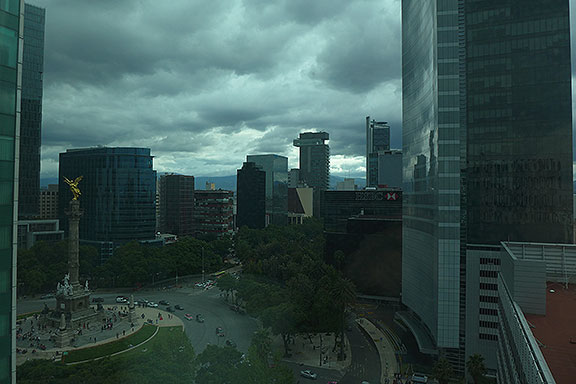 Hilariously I got to stay in the Sheraton near the Angel de la Independencia for some time… constant amazing views of the stormy evening clouds and the crazy mix of quinceanaras and political protests at the monument. Neoliberalism and Populism: Is That All There Is?
There are stark differences in personality and political style between Clinton and Trump, and most people who vote will choose one or the other. But millions of thoughtful people, probably a large majority, feel shut out, left to ponder how we might reorganize the way we live, from the bottom up.
For decades, there has been a mainstream neoliberal consensus, which holds that global trade is good and markets are more efficient than governments at meeting human needs. With the choice limited to centrist Democrats like Obama and the Clintons or ever more right-wing Republicans from Reagan to G.W. Bush, there has been no room for a critical alternative to the assumptions that government’s overriding priority is to facilitate the success of corporations and that the U.S. military should be used to police the world on their behalf.
Neoliberalism — a term widely used around the world, though less so in the United States — is an ideology Margaret Thatcher summed up in the early 1980s as “There is no alternative” to market forces. The reality that a tiny few have grown incomprehensibly wealthy while millions live at the edge of losing everything and millions more are in dire poverty (in the U.S. and the rest of the world) is dismissed as unimportant by the proponents of capitalist globalization. They continue to insist that the rigged game they’re playing will eventually benefit everyone, all evidence to the contrary notwithstanding.
A government dominated by millionaires, who fill most seats in the Senate and many in the House, has eroded belief in the system. This simmering rage against the corrupt and the rich found its voice during this election campaign. Both Sanders and Trump hammered at the trade deals that have been the cornerstone of global neoliberalism. Sanders managed to force Clinton to repudiate the TransPacific Partnership (TPP), though everyone knows that if she is elected, she will continue the Obama administration’s embrace of international trade pacts. Trump has upended the Republican establishment and their support for corporate freedom from government regulation nationally and internationally. No one can predict what he would actually do if he is elected, but he has put opposition to trade agreements like the TPP or NAFTA at the center of his campaign.
This nationalist economic rhetoric, which includes on the right the scapegoating of immigrant workers, has a long and sordid history. It is not surprising that a right-wing demagogue could find support by tapping into this century-old wellspring of animosity and resentment, used again and again to divide workers from one another. Even Cesar Chavez’s United Farmworkers Union, still revered by people on the left who support unions, scapegoated immigrant workers and engaged in their own border patrols to stop them in the early 1970s.
 One hundred thousand farmworkers gathered in the center of Mexico City a week ago to demand resources and policy changes from the government. Few remember now that, 17 years ago, it was the left-wing critique of trade deals that originally united the “Teamsters and turtles” in Seattle to halt the World Trade Organization talks in 1999. The common argument of organized labor then demanded “fair trade” rather than “free trade,” but many of us went to Seattle to reject that simplistic choice. The Committee for Full Enjoyment (not Full Employment) argued for “Life Not Trade!”
The anti-globalization movement with its cacophony of critical ideas and demands appeared many times in the years since, from the IMF/World Bank meetings in Washington DC in 2000, to the violent confrontations in Genoa, Italy in 2001, to a whole series of G-8 and other “summits” that faced major social resistance in Sweden, Quebec, Germany, Thailand, Miami and so on. The movement had deep roots in the Zapatista rebellion against NAFTA in Mexico in 1994, as well as uprisings in dozens of countries against IMF-imposed “structural adjustment programs” — the privatization of public works and public services, according to the neoliberal “Washington Consensus.”
Unlike mainstream unions (which usually avoided these protests) the anti- or alter-globalization movement didn’t reject internationalism; the World Social Forum emerged from it as a rejoinder to the elite’s annual gathering in Davos, Switzerland under the rubric of a World Economic Forum. The World Social Forum, which convened in Montreal, Canada last week, is a regular global meeting of movements focused on defining and constructing real alternatives to the way we live today. This process of knitting together global networks committed to a post-capitalist future has held its own summits in Brazil, India, Kenya, Mali, Venezuela, Pakistan, and Tunisia, but has fallen far short of everyone’s most cherished hopes.
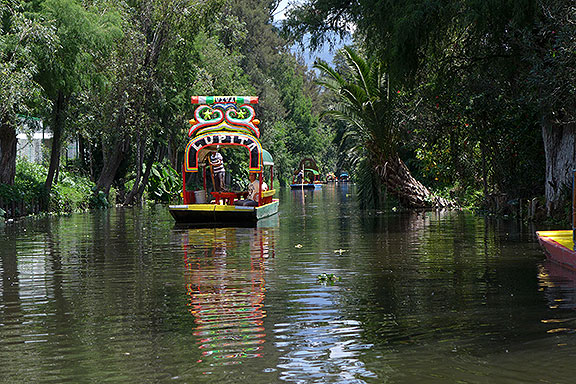 Spent a fun afternoon with my classmates and other friends visiting Xochilmilco, the famous waterways south of the city. 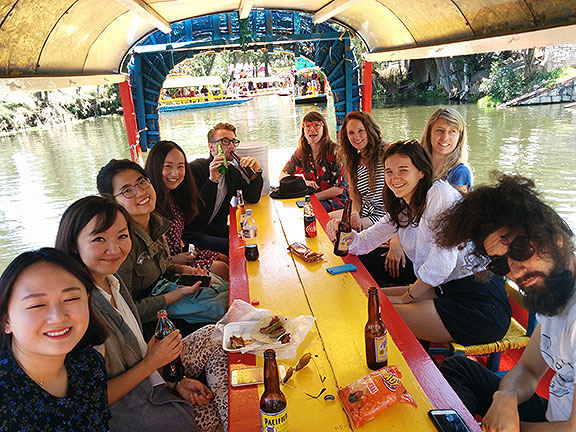 Classmates and friends and more! 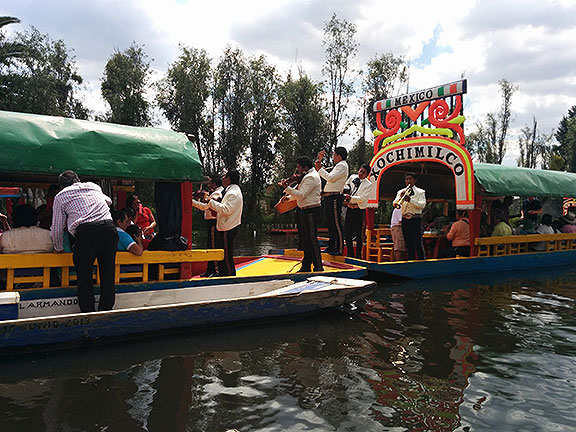 We even hired a mariachi band for a tune! 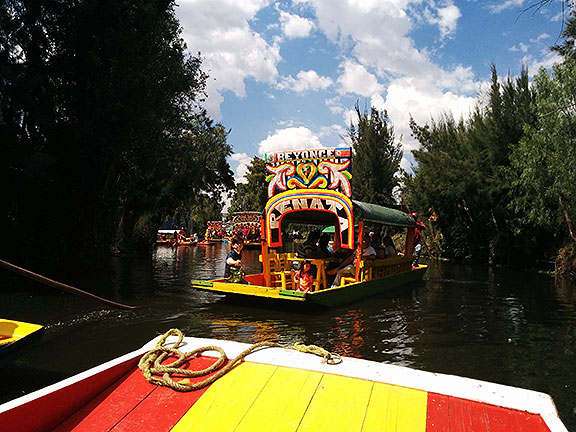 It was a gorgeous afternoon. Where can we look for change? Not in the form of mass organizations or political parties that contest directly for state power (though halting efforts towards this have emerged in Spain and Greece for example), but perhaps in the decentralized network of social movements that are difficult to recognize as such. One example would be the myriad groups trying to address the catastrophic ecological predicament we’ve put ourselves in. Jonathan Schell, writing in The Unconquerable World more than a decade ago, suggested that there were about 30 million such organizations worldwide.
Activists like these share some key characteristics. Many people are taking their time and technological know-how out of the market place and engaging in useful, practical projects to improve lives in the here and now. People want an alternative to just surviving on flat wages and with inflated housing costs. Many find it by working, usually for free, on projects that address the ecological crisis, social dislocation and the meaninglessness of most jobs.
The madness of perpetual growth as the raison d’etre of our economic life is never questioned. When we are urged to vote for Clinton or Trump, neither vote will challenge this reality.
The system is failing. Eventually, an alternative to the corrupt kleptocracy that runs it will emerge from the enormous creativity and compassion, daily cooperation and mutual aid that already undergirds much of our social life. The change is all around us as millions of people already participate in networks of mutual aid and solidarity, creatively reappropriating technology and skills to address their problems. These are the seeds of a new way of life.
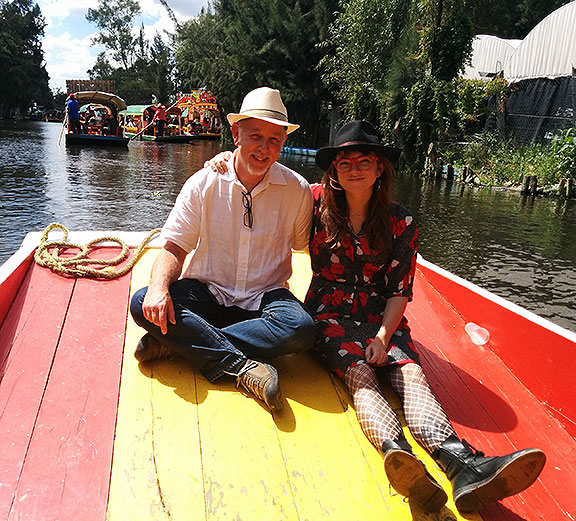 Even my daughter came along! 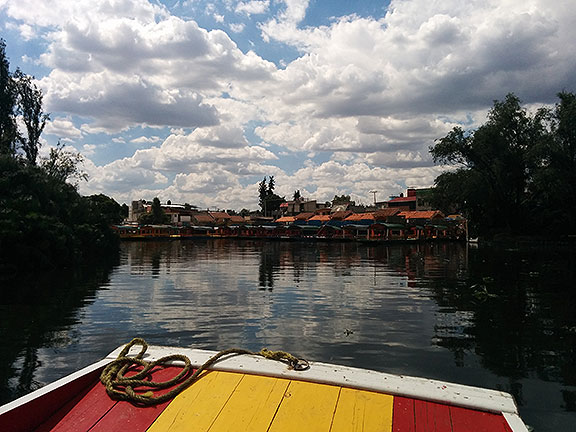 Returning to dock, what a sky!
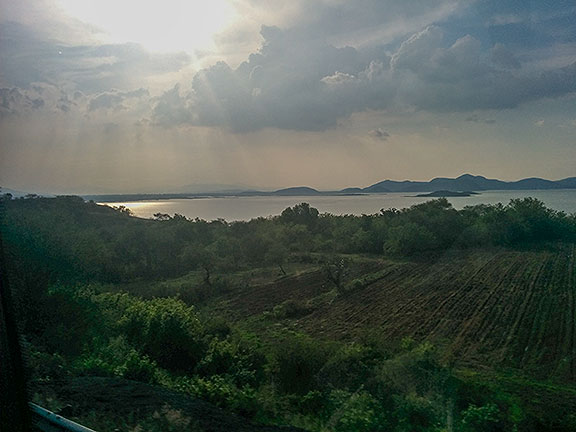 Lago de Cuitzeo on the road near Morelos, during the bus ride from Mexico City to Guadalajara. I’m in Mexico City. I arrived a couple of weeks ago and will be here until mid-August. I’m enrolled in a Spanish class at the UNAM, Mexico City’s enormous free public university, and I’m staying in a very gentrified neighborhood called La Condesa, in an apartment that is a bit of a dump, but it’s working out ok.
Learning Spanish has been a goal that I’ve intermittently felt committed to since 1979. As it happens, I’ve had many experiences in Spanish-speaking countries, and living in the Mission with a Mexican wife gives me lots of regular opportunities to be in Spanish speaking situations. Still, in spite of all that, I have always had a lot of trouble speaking, and my comprehension is very unreliable, going from 25% to close to 80% at times. After my visit to Chile in March/April of this year, I finally broke through a persistent ceiling and found my tongue. It doesn’t mean I don’t speak very garbled Spanish, but at least I can generally make myself understood and I can usually understand what people are asking of me. Now I’m in a Basic 4 level class, and once again am face to face with the task of memorizing long lists of verbs and conjugations, something I started to do 36 years ago when I was in a Spanish program at SF State, but haven’t really tried to do since then.
So far, after two weeks with four to go, I’m feeling happy about my progress. I still can’t come up with the correct verb forms most of the time, but I do feel more in the moment and capable of interacting with people as needed. I also have to face the fact that I’m actually not that extroverted when it comes to just walking up to total strangers and talking to them.
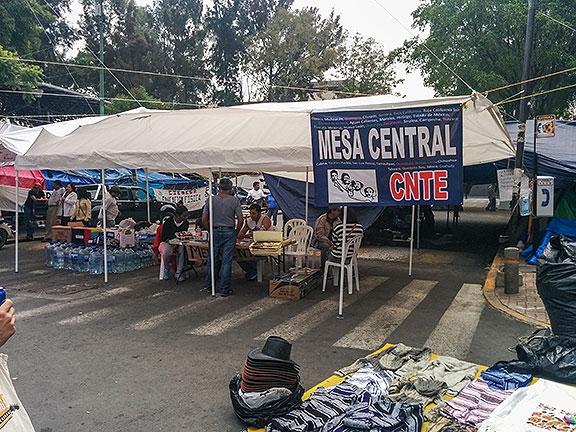 The ongoing nationwide protests by teachers against the neoliberal reform program installed by the Federal government has brought thousands of teachers from near and far to a huge camp-out near the Ministry of Education. We took a walk to the center of town a couple of days ago and accidentally found ourselves passing through riot cops and giant metal barricades. After we emerged from that (they were all lounging around and nothing was “happening” at the time) we found ourselves a couple of blocks later in the midst of a sprawling tent city of striking teachers from all over Mexico that have gathered in the area to pressure the Ministry of Education and to demand that the neoliberal program of education reform be rescinded. It was interesting, though I didn’t get into any conversations as we wandered around amidst the many tents and small tiendas.
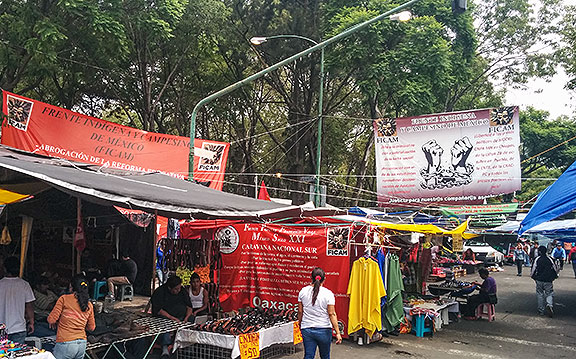 Countless tents and banners proclaiming the goals clog several square blocks in the heart of Mexico City. 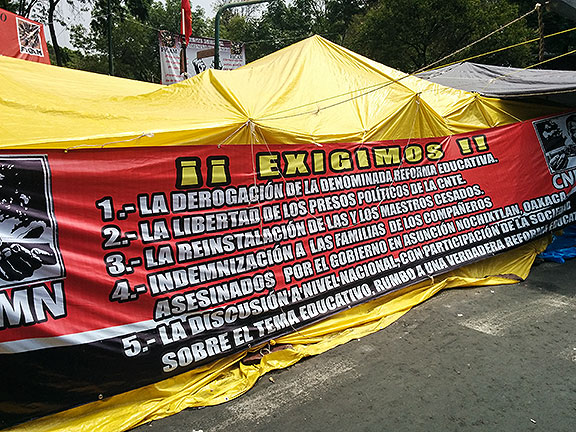 The demands are everywhere… release the teachers jailed during protests, halt the reforms, etc. Since arriving I’ve been following the movement of teachers in the excellent local newspaper La Jornada. There have been daily blockades in many Mexican states, from Oaxaca and Chiapas to Nuevo León and Michoacán. In Oaxaca there was another massacre in a town called Nochixtlán where a half dozen teachers were gunned down, apparently by goons employed by the former governor of the state. The teachers movement is complicated by the fact that there are two unions claiming to represent them, the state-run, top-down SNTE, and the independent union that most of the active teachers are affiliated with, the CNTE. It is the latter that is camped out in Mexico City over several square blocks.
I am far from expert about the struggle underway, but clearly the teachers are demanding the rollback of the neoliberal reforms that have been established by federal law. The reforms subject teachers to testing and suspend their labor rights under previously established labor law, typical of neoliberal, market-inspired reforms. The CNTE doesn’t recognize the negotiations that are underway between the Ministry of Education and the SNTE, and are involved in their own three-part negotiations with subordinates of the Education Minister. The blockades have stopped major highways in many parts of the country, and clearly the government is backtracking and trying to find a way to wait the movement out, or to offer minor concessions that don’t affect the deeper attack on teachers, but the teachers are so well organized and so well informed, it seems unlikely that the Mexican government will be able to avoid re-doing the entire package of educational reform. For now, it’s a high tension game of negotiations and direct action, fascinating to see.
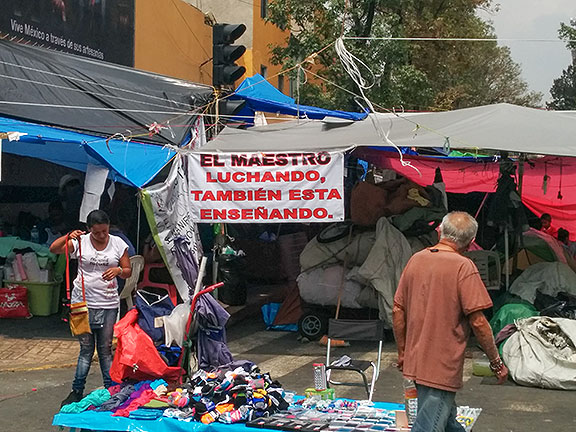 The teacher fighting is also teaching. I saw in the paper a few days ago there was going to be a book launch for a new book called “Mexico Armed,” by Laura Castellanos. I went to the event at the publisher’s offices at the edge of Colonia Roma, where two rooms were jam-packed with over 100 attendees. It was extremely interesting for me, and happily, I felt I could understand nearly everything, even the jokes! So a real sense of progress. The discussion by the four different speakers, including the author, emphasized that the sclerotic Mexican political system had again and again met civic protest with violence and that it was state violence that preceded the emergence of armed struggle groups in Mexico in every instance covered in the book, over 30 different examples between 1943-1981.
Continue reading Never Too Late? Estudiando Español en Mexico!
“Dredgefest” appeared out of the blue in an email a couple of months ago, a title I couldn’t resist. I taught a class at the SF Art Institute a couple of years ago called “Dredge” so I didn’t think twice before signing up for their Saturday June 18 bus tour of bay shoreline sites. I was not disappointed! The tour visited three locations, Hamilton Field in Marin County, Sears Point National Wildlife Refuge on the northern shore of San Pablo Bay due south of the intersection of Highway 37 and the Lakeville Highway, and finally the Cullinan Ranch restoration project just west of Mare Island near Vallejo. Each site is former military and agricultural land being returned to marshland, with differing levels of deliberate design and engineering interventions.
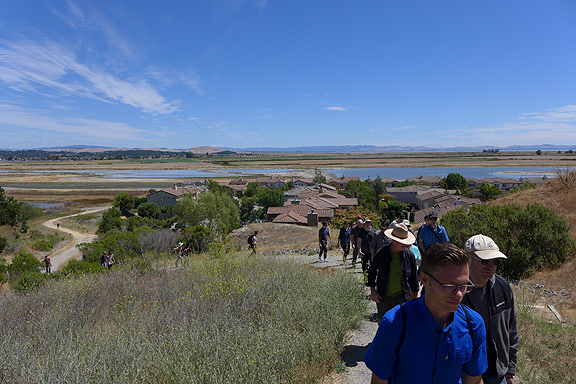 A full bus load of mud lovers, bird watchers, landscape engineers, hydrologists, citizen scientists, and radical librarians climbing a low ridge above Hamilton Field, once an airforce base with below sea level runways, now a showcase restoration project on the Marin County bay shore.  In the native plant nursery at Hamilton Field some helpful maps helped situate us. HWRP is the Hamilton Field Wetlands Restoration Project. 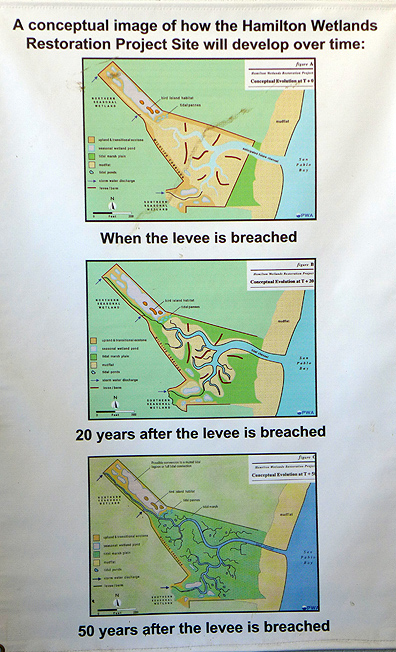 This is the closely designed plan for the former air base. For two years, 24/7, dredge materials from excavation at the Port of Oakland was pumped through an “Aquatic Transfer Device” specifically designed for this project (with a dedicated substation to provide enough power to run two 700 horsepower pumps fulltime) into the site to help contour the lands to become tidal marshes as soon as possible after the 2014 dike breach. Not only did the project carry out the dike breach on schedule in 2014 but apparently natural processes are in fact developing largely as planned. Against all odds, things are going very well! 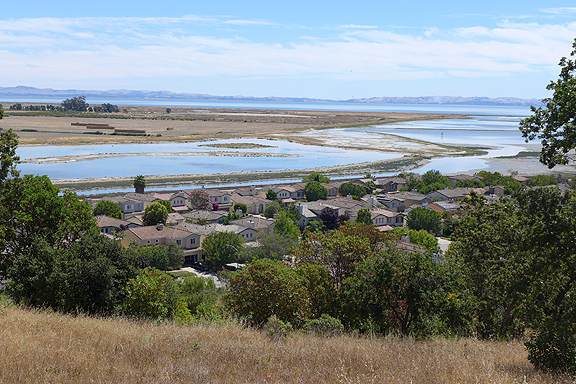 A variety of berms and data gathering stations help marshland dynamics re-emerge while providing the measurements to help the biologists and hydrologists figure out what went right and what didn’t. As you can see in the previous photo, the Hamilton Field restoration also includes parcels dedicated to suburban housing development. We were treated to detailed explanations of the ten-year multi-agency effort to raise the underlying lands enough to allow for successions of plant and animal life to flourish in the new/old wetlands. But the technical discussions of landscape design didn’t impress me as much as the remarkable story of bureaucratic cooperation and adaptation to overcome an endless series of budgetary, jurisdictional, political, and conceptual disputes. Unlikely coordination was achieved between the Army Corps of Engineers, the Port of Oakland, the Bay Conservation and Development Commission, the California Coastal Conservancy, the California State Water Board, the California State Lands Commission, California Fish and Wildlife, NOAA Fisheries, the Environmental Protection Agency, and more that I can’t remember.
The key to the Hamilton Field project was getting the dredge materials from the Port of Oakland, where the Army Corps is responsible for maintaining channel depths, and since it was decided to lower the channel depths from 42′ to 50′ to accommodate the new massive container ships, the Port and the Corps had a huge disposal problem. The Hamilton Field restoration project is one of the first to successfully use millions of cubic yards of bay dredge material to implement plans to remake historic marshlands. Until a decade ago, many environmental groups were opposed to the concept, assuming that it was a ruse to allow industry to dump toxic dredge with a “greenwashing” cover story. But according to the participant-experts who explained the project to us, the successful remaking of flourishing habitat for endangered species has won over most if not all of the critics and muted opposition to expanded efforts on other bayshore sites.
Continue reading Remaking Baylands While Preparing for Sea-level Rise
|
Hidden San Francisco 2nd EDITION!

NEW 2nd EDITION NOW AVAILABLE!
Buy one here
(Pluto Press, Spring 2025)
|




























